Kirisun Communication W60W65 POC Trunked Two-way Radio User Manual General
Kirisun Communications Co., Ltd POC Trunked Two-way Radio General
user manual
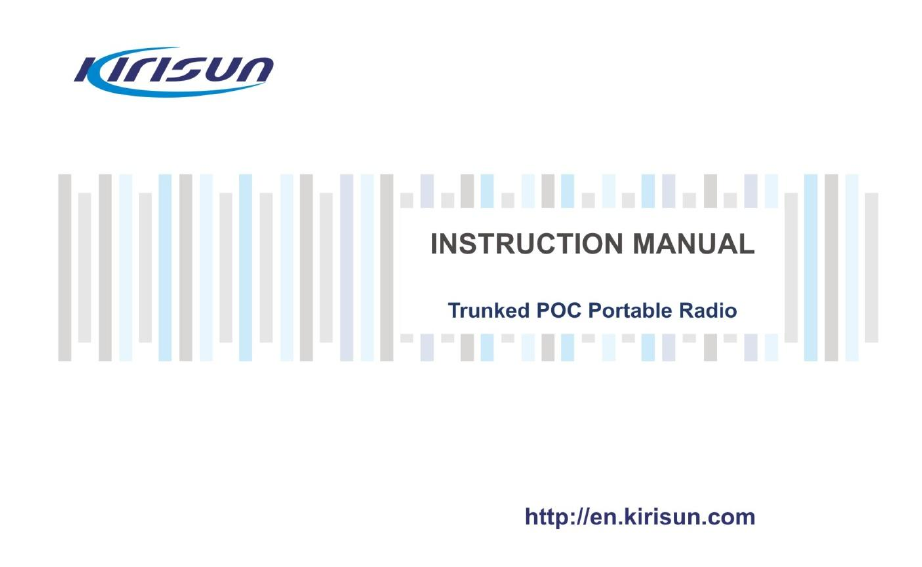

Trunked POC Portable Two-way Radio Quick Reference Guide
Instruction Manual
Trunked POC Portable Radio
We are very grateful for your purchasing Kirisun brand two-way radio produced by
Kirisun Communications Co., Ltd.
We believe Kirisun two-way radio, which always incorporates the latest technology, can
bring great convenience to your life and work. We also believe that the quality and
function of Kirisun two-way radio can meet your demands for reliable communication.

Trunked POC Portable Two-way Radio Quick Reference Guide
1
Contents
Safety ........................................................................................................................................... 2
Regulatory ................................................................................................................................... 7
Caring for your product .............................................................................................................. 8
Connectors, controls, buttons and keys .................................................................................... 9
Keys, buttons and knobs overview .......................................................................................... 11
LED status indicator .................................................................................................................. 12
Battery information ................................................................................................................... 13
Accessory information .............................................................................................................. 17
Basic operation ......................................................................................................................... 20
Technical specifications ........................................................................................................... 24

Trunked POC Portable Two-way Radio Quick Reference Guide
2
Safety
Read these safety instructions carefully.
It is the responsibility of the person operating the product to ensure that it is operated safely at all times,
and that local laws and regulations governing the usage of Radio Frequency (RF) products are
observed. Obey all signs and instructions relating to the usage to RF wireless devices
It is recommended that you obtain training on how to safely operate this product. Your personal safety
could be affected if you do not understand how to operate this product correctly.
This product must not be operated in environments that exceed those listed in the product technical
datasheet and in the Regulatory section of the product user guide.
Unauthorised modifications to the product could cause the product to become non-operational. Always
use Kirisun approved antenna, battery and accessories with this product.

Trunked POC Portable Two-way Radio Quick Reference Guide
3
Exposure to RF energy
Kirisun designs and manufactures products to meet strict guidelines and international standards
relating to Radio Frequency (RF) energy and the potential health risks associated with using such
products. If you have any concerns about potential health risks associated with long term exposure to
RF energy, you should obtain advice from your employer.
RF energy interference with electronic equipment
Some personal medical devices, such as hearing aids and pacemakers, can be affected by RF energy.
Always consult your service provider or the manufacturer of the medical device before using RF
wireless devices.
Some electronic devices are sensitive to RF energy. POWER OFF your radio when operating within
health care facilities or other areas that are sensitive to RF energy.
Safely operating your radio
Your radio is not intrinsically safe and has not been designed for use in hazardous environments such
as gas fumes, flammable chemicals, or blasting areas. Check the compliance ratings of this product
before operating the radio in any hazardous environment.

Trunked POC Portable Two-way Radio Quick Reference Guide
4
Your radio should be used in its normal operating position when hand-held, worn on the body or
secured within a cradle. Always ensure that the antenna is pointed away from the body, particularly the
eyes. When body-worn, the radio must be secured using Kirisun approved attachments. Always ensure
that your radio is operating correctly before entering any environment that has a potential risk to
personal safety.
Only remove the antenna, battery or accessories when it is safe to do so.
Protection against hearing loss
NEVER place the radio next to your ear, like a mobile phone when making a PTT call. Your radio has a
powerful loudspeaker that could potentially damage your hearing if held next to your ear. Always check
the volume level before making and receiving calls.
Safety when driving a vehicle
Always obey local laws and regulations governing the operation of RF wireless devices when driving
and whilst at locations. Do not operate your radio if it creates a distraction from driving safely and
observing road conditions.
Always POWER OFF your radio at refuelling stations and obey warning signs relating to the use of RF
wireless devices in the vicinity of refuelling stations.

Trunked POC Portable Two-way Radio Quick Reference Guide
5
Important safety notes about the Antenna
NEVER touch the antenna when the radio is transmitting, this may cause a minor burn to the skin and
may affect the operational range of the antenna. NEVER use your radio if the antenna shows signs for
damage.
DO NOT handle, hold or swing the radio by its antenna, because this may damage the antenna and the
radio. Do not chew the antenna or place it into your mouth. NEVER use your radio without an antenna
attached. Transmitting without an antenna may damage the radio. Only use a Kirisun approved
antenna with your radio.
Operational Conditions
Do not exceed the operational conditions for the radio and battery. Always check the technical data for
this product before attempting to operate the product in extreme conditions. Leaving the radio in
extreme temperatures, for example behind glass indirect sunlight may cause damage to the casing and
the battery.
Care should be taken to avoid mechanical impact.
Accessories
Kirisun products have been tested to meet strict guidelines for personal safety and operational
conditions. Only accessories approved by Kirisun are recommended for use with this product. Always
read the instructions supplied with the accessory for additional safety instructions.

Trunked POC Portable Two-way Radio Quick Reference Guide
6
The use of non-approved accessories may invalidate any product warranty. If a non-approved
accessory is fitted, it may compromise the product safety ratings.
Always fit the RAC cover when an accessory is not in use.
Safe installation into vehicles
Electronic control mechanisms within a vehicle can be affected by the use of RF energy such as ABS
and transmission controls. Always refer to the vehicle manufacturer’s instructions and technical
information relating to electronic modules and their wiring harnesses before installing an RF wireless
device into a vehicle.
Do not install the product within the air bag deployment area. In the event of the air bag deflating, the
radio could be propelled at great force potentially causing serious injury.
Servicing
Do not attempt to dismantle this product. Servicing and repairs to this product must be performed by
trained service technicians at Kirisun approved service centres.

Trunked POC Portable Two-way Radio Quick Reference Guide
7
Regulatory
Kirisun declares that this product is compliant with the essential requirements and other
relevant provisions of the European R&TTE directive 1999/5/EC relating to radio and
telecommunications terminal equipment and the mutual recognition of their conformity.
This product is also compliant with directive 2011/65/EU having been designed and
manufactured to the RoHS requirements.
Waste Electrical and Electronic Equipment recycling
This symbol on the product or its packaging indicates that this product must not be disposed of
as household or commercial waste. Some countries have set up collection and recycling
systems for waste electrical and electronic products. By ensuring that this product and its
packaging is disposed of correctly, you will help prevent potentially negative consequences for
the environment and human health, and help conserve natural resources. Please dispose of
your waste product according to your national and local regulations. Contact your service provider or
Kirisun for information about disposing of this product in your region of the world.
Disposing of batteries
Your radio is supplied with a rechargeable lithium-ion battery. This symbol on the battery and
its packaging indicates that it must not be disposed of with household or commercial waste.
Please dispose of your waste batteries according to your national and local regulations.
Contact your service provider or Kirisun about recycling batteries in your region of the world.

Trunked POC Portable Two-way Radio Quick Reference Guide
8
Caring for your product
Your radio does not require regular servicing. Caring for your radio as described in this guide will help
maintain the product in good operational condition.
Kirisun supplies a range of accessories to protect the radio during use, including a protective cover.
Contact Kirisun for more information.
Always wear eye protection when using brushes or other tools to remove debris from connectors or
other parts of the radio.
Do not use chemicals, aerosols or abrasive cleaners. Chemical coatings must not be applied to any
part of the radio or battery.
Clean the exterior surfaces daily using a lint free soft cloth.
Clean the battery contacts periodically using a soft brush
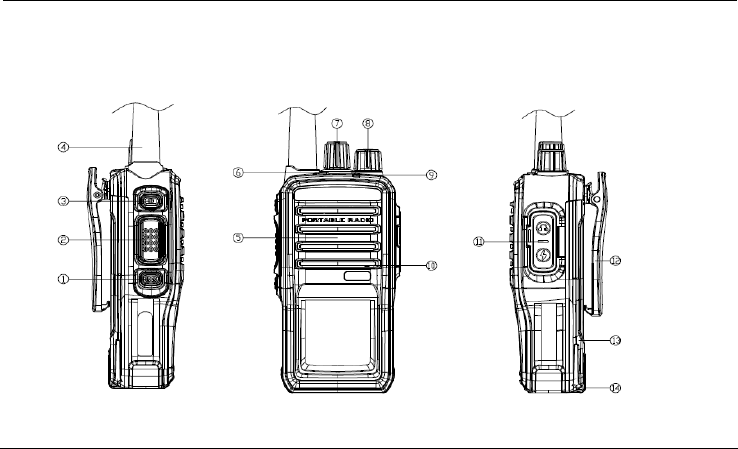
Trunked POC Portable Two-way Radio Quick Reference Guide
9
Connectors, controls, buttons and keys

Trunked POC Portable Two-way Radio Quick Reference Guide
10
Refer to the illustration for the location of the following connectors, controls, buttons and keys:
(1) Programmable side button 1
(2) PTT button
(3) Programmable side button 2
(4) Antenna
(5) Speaker
(6) Top key
(7) Channel selector knob
(8) Power/Volume knob
(9) LED status indicator
(10) Microphone
(11) Rugged accessory connector (RAC) with cover (screw fixing)
Micro USB slot and earphone slot
(12) Belt clip accessory
(13) Battery
(14) Battery latch

Trunked POC Portable Two-way Radio Quick Reference Guide
11
Keys, buttons and knobs overview
Power switch / Volume knob
To power on, rotate clockwise.
To power off, rotate counter-clockwise.
To increase the volume, continue rotating clockwise. Rotate counter-clockwise to decrease the volume.
Channel knob / Group selector knob
Rotate clockwise to change channels / groups. Your service provider may program your radio up to 16
channels with contact groups or persons.
Top button (Programmable)
It’s programmable to support the following functions: broadcast battery / broadcast user name /
broadcast group name / download voice record / open contact list. It supports defining function for two
actions: “ long press” and “ short press”
Side button (Programmable)
It’s programmable to support the following functions: broadcast battery / broadcast user name /
broadcast group name / download voice record / open contact list. It supports defining function for two
actions: “ long press” and “ short press”
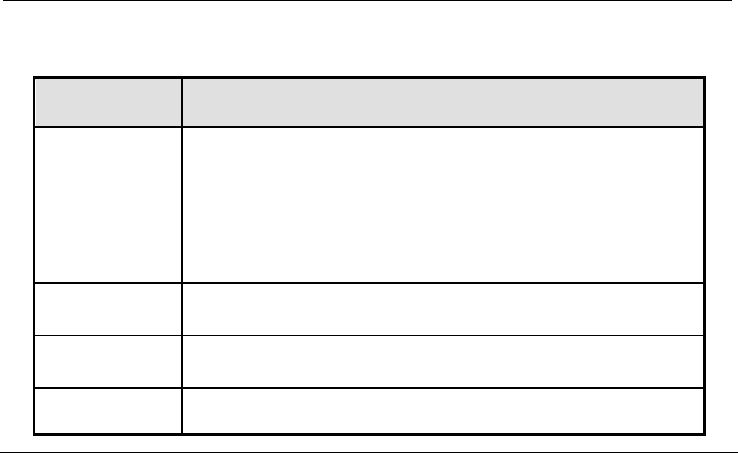
Trunked POC Portable Two-way Radio Quick Reference Guide
12
LED status indicator
The LED changes colour to show the operational state of your radio.
LED
Operational State
Solid red
- Fail to insert SIM card or SIM card was installed wrongly, voice
prompts "mobile phone card read failure"
- This device is not added in the server
- Device is added, but its group selector knob is not set
successfully
- SIM card PIN unlock unsuccessfully, and the voice prompts "PIN
ERROR"
Solid green
- Calling status (group call / single call / duplex / all call)
- In the status of downloading or playing voice records
Solid yellow
- Standby status for individual call
- Standby status or setting up status for duplex call
Flashing red
- SIM card is not activated or in deficit, so the device cannot
register to the wireless network
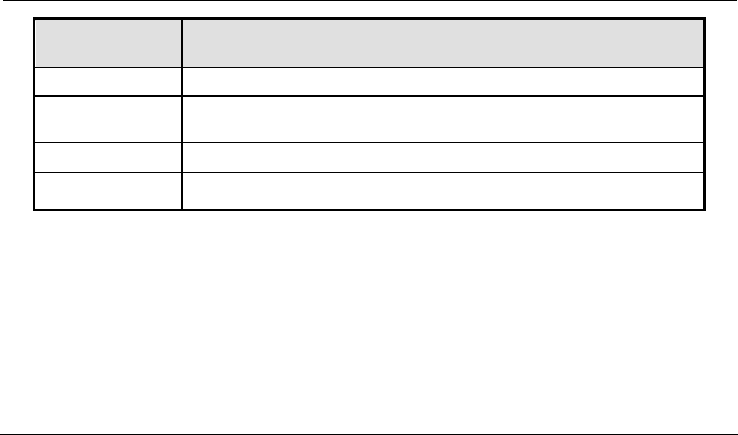
Trunked POC Portable Two-way Radio Quick Reference Guide
13
LED
Operational State
- Wireless signal is poor, so the device cannot register
Flashing green
slowly
- Has successfully registered in the server, enter the standby mode
Flashing yellow
- In the status of registering to the network;
No indication
- Radio is in ‘idle’ mode or is powered off.
Battery information
Your radio is supplied with a Kirisun approved battery to provide optimum performance. If you battery is
new, it may need to be fully charged before first use. Always ensure your battery is fully charged before
you start your shift.
The following guidelines will help you get the best performance from your Kirisun battery and help to
ensure your safety.
Battery safety
Refer to the instructions supplied with the charger for more safety information.
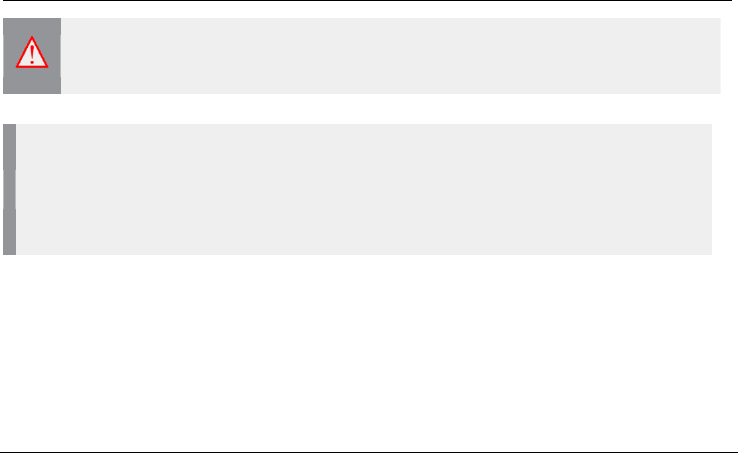
Trunked POC Portable Two-way Radio Quick Reference Guide
14
Storage and transportation
Use the original packaging to store and transport batteries. To obtain the best performance from your
battery, store it in a cool dry place. Failure to store batteries correctly could lead to reduced capacity
and battery life
Do not store a fully charged battery for periods exceeding 6 months. For storage periods exceeding 6
months, apply a conditioning charge of 7 minutes for standard and 12 minutes for high capacity
batteries every 6 months.
Storage temperature guidelines:
Warning: Take care when handling and charging batteries. Accidental short-circuiting of
the battery electrical circuit (battery radios) by metal objects may cause bodily injury such
as a burn. Do not disassemble, mutilate or incinerate the battery.
Caution: This radio has been tested and certified using a Kirisun approved battery. Using non-
approved batteries may damage the radio and invalidate any product warranty.
When recharging batteries, always ensure that the battery charger is placed in a well-ventilated
area away from combustible materials.
Never use a battery that shows signs of damage (not minor scratches) or has been dropped or
received a ‘sharp blow’. Damage to the battery may not always be obvious.

Trunked POC Portable Two-way Radio Quick Reference Guide
15
<1 months -20 to +55 °C (-4 to 131 °F)
1 to 3 months -20 to +40 °C (-4 to 104 °F)
>3months -20 to +30 °C (-4 to 86 °F)
Charging your battery
If the battery is new, it is important that it is fully charged before first use.
Your radio will sound an audible alert when the battery has less than 15% charge remaining.
Typical charging time is approximately 3-4 hours. This may vary depending on the battery and
environmental conditions.
Charge your battery between 5°C to 35 °C (41°F to 95°F) temperatures only.
Always ensure that the radio is powered off before charging the battery.
This radio provides 3 types of charging:
1) Charging with the micro USB slot in the RAC ( battery attached in the
boy of radio)
Connect the data/charging cable to the micro USB in the RAC, the LED
indicator at the top of the radio can show the charging status.
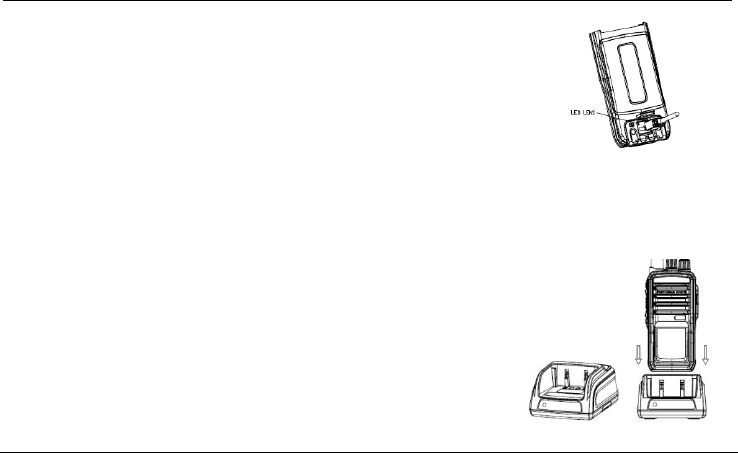
Trunked POC Portable Two-way Radio Quick Reference Guide
16
2) Charging with the micro USB slot at the bottom of the battery
Remove the battery from the body of the radio, connect the data/charging
cable to the micro USB slot at the bottom of the battery. The LED indicator
can show the charging status.
3) Charging with the charger (charger is optional accessory)
The charger must be placed onto a flat surface away from flammable materials when charging.
Place the battery into the charger pocket by aligning the slots on the battery with the guides on the
charger pocket. It is not necessary to remove the battery from the
radio when charging. Ensure the battery (or radio with battery
attached) is secure in the charger pocket.
Never leave the battery or radio with battery attached in the charger
when not charging.
The charger unit has LEDs that indicate the state of charging.
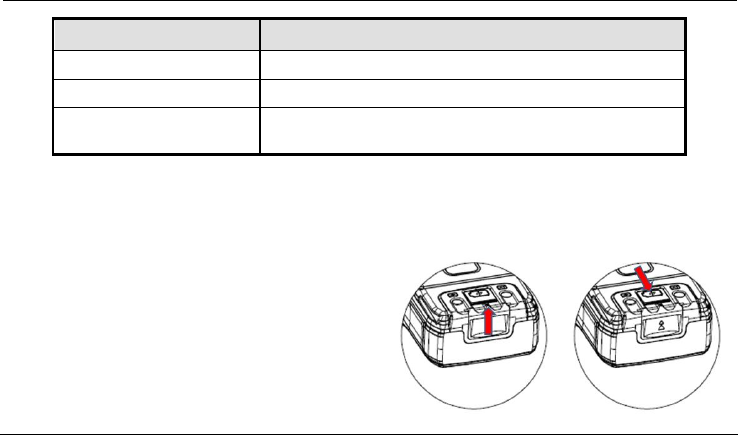
Trunked POC Portable Two-way Radio Quick Reference Guide
17
Charger LED
State
Solid red
Battery is charging.
Solid green
Battery is fully charged. Standby mode without battery.
Flashing yellow
Battery is damaged. Contact your service provider or
Kirisun.
Accessory information
Fit the battery
Align the battery with the two slots on the back of
the radio.
Carefully slide the battery forward along the slots
until it clicks into place.
Remove the battery
Ensure the radio is powered off.
Push the battery latch upwards. Slide the battery
backwards until it detaches from the radio.
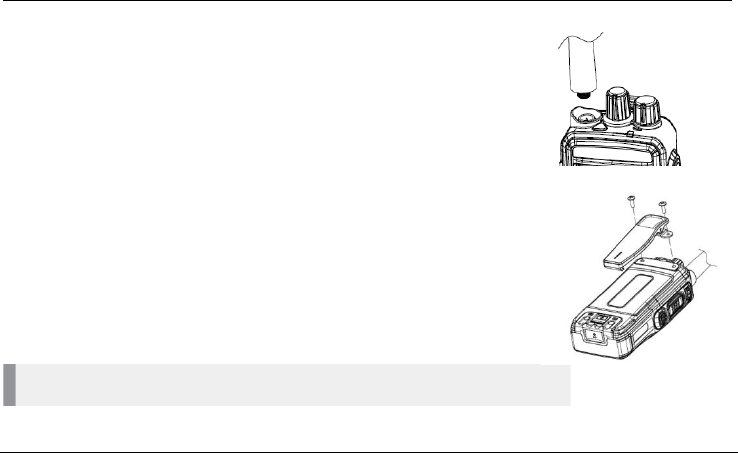
Trunked POC Portable Two-way Radio Quick Reference Guide
18
Fit the antenna
Ensure the radio is powered off
Place the antenna into its receptacle
Rotate the antenna clockwise until finger tight.
Fit the belt clip
Ensure the radio is powered off.
Remove the two screws at the back of the radio using a cross-head PH1
screwdriver.
Align the screw holes on the belt clip with the mounting holes on the
back of the radio.
Secure into position using the two screws.
Caution: Do not over tighten the screws, this may damage the product.

Trunked POC Portable Two-way Radio Quick Reference Guide
19
Connect the programming cable
Open the RAC fist, then plus the data/charging cable into the micro
USB slot in the RAC.
Fit earphone (earphone is optional accessory)
Open the RAC cover first, then plug Kirisun-approved earphone into
the slot in the RAC.

Trunked POC Portable Two-way Radio Quick Reference Guide
20
Basic operation
Power on/off
To power on, rotate the Power/volume knob clockwise.
To power off, rotate the Power/volume knob counter-clockwise until the knob clicks.
Standby
First boot after installed battery, it will take about 50s to register in the server. Then if turn off the power,
the radio will get into sleep mode to maintain the minimum power consumption. If turn on again, it will
takes just 10 seconds to register. After successfully registered, the radio will get into the standby status
waiting for group call.
Adjusting the volume
Rotate the Power/volume knob clockwise to increase the volume.
Rotate the Power/volume knob counter-clockwise to decrease the volume.
Selecting a channel
Your service provider may program the radio with up to 16 channels with either a contact group or
person.
To change the channel, rotate the channel selector knob.

Trunked POC Portable Two-way Radio Quick Reference Guide
21
Call duration setting
To avoid occupy right to speak too long, it provides setting for call duration, Time periods range from 30
to 90 seconds, and can be set in the configuration tool. At the end of the time period, the call will be
terminated automatically no matter the calling is finished or not.
Making a PTT call
Press PTT key to initiate a call, if there is no group member online, then voice prompts “no user online”,
otherwise the indicator turns green to indicate the call has gotten through. Release the PTT key to
finish the call to enter the standby status
Receiving a PTT call
When the radio is in standby status, if a call comes, the indicator will turn solid red. When the call is
finished, a sound ‘Di’ can be heard. When the call is finished, If it’s a group call, the indicator will flash
green slowly; if it’s a individual call, the indicator will turn yellow. If want to call back, press PTT button.
Delay access
Allow radio to access an ongoing group call after a period of time

Trunked POC Portable Two-way Radio Quick Reference Guide
22
Priority call
Allow setting different priorities for each radio. The radio with higher priority can make a call prior to
others
Calling types
Group call
After boot, the radio will enter standby status waiting for group call, press the PTT button can make a
group call, and by rotating the channel / group selection knob can switch between the groups
Individual call
First, do the setting for “friend person” for radio in the management platform. Press the programmable
key which is programmed to be with “individual call” function, enter into “individual call mode”, there is a
voice prompts the status and broadcast the name of individual person / radio in the other end. Press
again to exit the individual mode. By pressing the side programmable key, each friend in the preset
friend list can be selected
All call
First, add an “All call” group with relevant members in the management platform. The radio with the
authorization of “All call” can call all the radios belonging to the account (agent / client / company etc),
no matter which group the radios are in at the moment. The all call will last for 30s, within this period,
every member in this call group could have right to speak.
Duplex call

Trunked POC Portable Two-way Radio Quick Reference Guide
23
Press the programmable button which is programmed to be with “duplex call” function, then enter the
duplex call mode, press PTT button to initiate the call, during the duplex call, the members in the call
can speak without pressing PTT button
*Duplex cal can’t be interrupted
Historical call record playback
Press the programmable button which is programmed to be with “download the historical call”, then the
radio can download and playback the historical call. It only supports to download five historical calls,
and this function should be opened in the management platform in advance.
Position information report
GPS function can report the radio’s position information to the management platform. Then radio’s
position can be shown in map in the management platform or dispatcher
Low battery alert
When the remaining battery is less than 15%, voice will prompt “low battery, please charge” first time.
When the remaining battery is less than 10%, voice will prompt “low battery, please charge” again
When the remaining battery is less than 5%, there will be a voice prompts “low battery, please charge”
at a certain frequency with the indicator flashing slowly
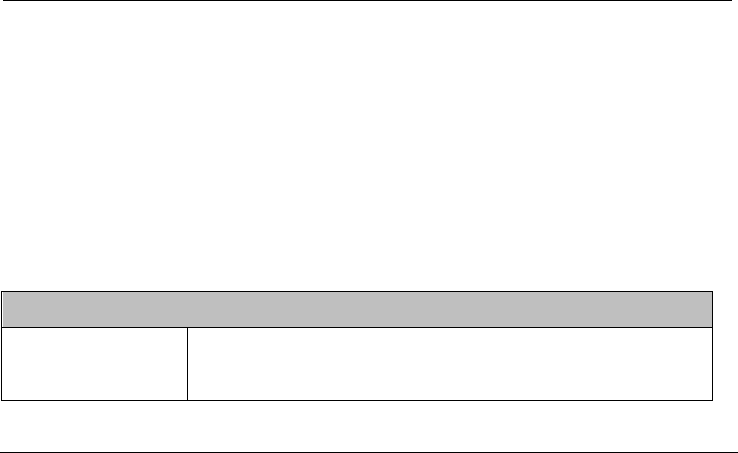
Trunked POC Portable Two-way Radio Quick Reference Guide
24
Remote programming
Allow programming the radio via 2G (GPRS) / 3G network by operating in management platform , or
via WIFI network by operating in configuration APP in Android phone.
WIFI network
Support access to WIFI network and open a hotspot for other devices. WIFI SSID and password can
be set through “PC configuration tool”
Advanced signalling function
Support functions of stun, revive and kill
Technical specifications
General
Communication Mode
& Frequency Band
3G: WCDMA 850Mhz+2100Mhz or WCDMA 900Mhz+2100Mh
2G: GSM 850M+900M+1800M+1900Mhz
WIFI: 2.4Ghz
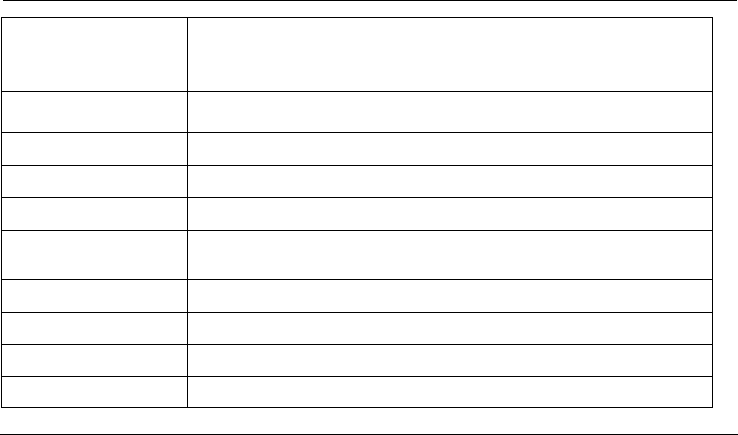
Trunked POC Portable Two-way Radio Quick Reference Guide
25
Channel Spacing
2G: 200kHz
3G: 5Mhz
(Follow 2G/3G protocol and managed by public telecom operator
Operating Temperature
-10℃ ~ + 50℃
Storage Temperature
-40℃ ~ + 80℃
Power Supply
DC 3.7V
Battery
3600mAh Li-ion
Dimension (H*W*D)
115mm*54mm*30mm
(with battery, without antenna)
Weight
330g (with battery and antenna)
Display
NA
Keypad
NA
Dustproof & Waterproof
IP65
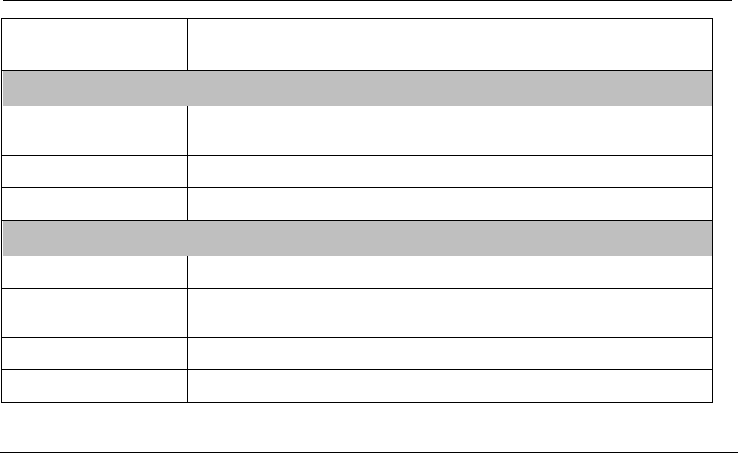
Trunked POC Portable Two-way Radio Quick Reference Guide
26
Battery Life (3600mAh)
2G mode: 22 hrs (GPS on); 25 hrs (GPS off)
3G mode: 15 hrs (GPS on); 16 hrs (GPS off)
Transmitter
RF Power Output
2G: 2W ± 0.5W
3G: 0.25W ± 0.1W
Frequency Stability
±0.1 ppm
Audio Distortion
5% (typical)
Receiver
Frequency Stability
±0.1 ppm
Sensitivity
2G: BER < 0.001 when Îor = 1µV;
3G: BER < 0.001 when Îor = 1µV
Rated Audio Power
1W
Rated Audio Distortion
5% (typical)
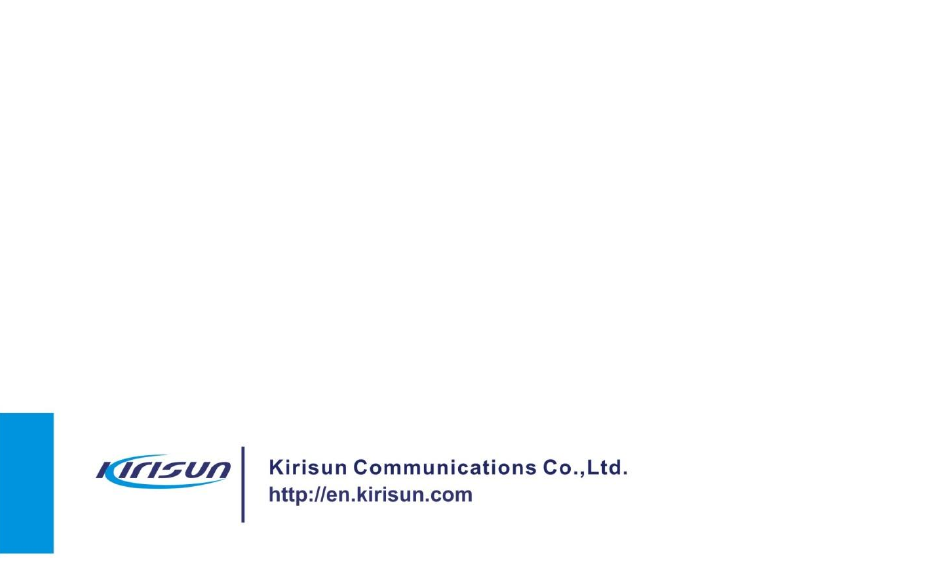

that cannot maintain 0m
25mm must be maintained between the user's face and the front of the PTT
from the face. To comply with FCC RF exposure requirements, a minimum separation distance of
When it is
FCC RF EXPOSURE INFORMATION:
WARNING!! Read this information before using your phone
In August 1986 the Federal Communications Commission (FCC) of the United States with its action
in Report and Outer FCC 96-326 adopted an updated safety standard for human exposure to radio
frequency (RF) electromagnetic energy emitted by FCC regulated transmitters. Those guidelines are
consistent with the safety standard previously set by both U.S. and international standards bodies.
The design of this PTT complies with the FCC guidelines and these international standards. Use
only the supplied or an approved antenna. Unauthorized antennas modifications, or attachments
could impair call quality, damage the PTT, or result in violation of FCC regulations. Do not use the
PTTwith a damaged antenna. If a damaged antenna comes into contact with the skin, a minor burn
may result. Please contact your local dealer for replacement antenna.
BODY-WORN OPERATION:
This device was tested for typical body-worn operations with the front of the PTT kept 25mm
, including the
antenna. Third-party belt-clips, holsters and similar accessories containing metallic components shall
not be used. Body-worn accessories
m separation distance between the user’s body and the back with belt clip of the
PTT, and have not been tested for typical body-worn operations may not comply with FCC RF
exposure limits and should be avoided.
For more information about RF exposure, please visit the FCC website at www.fcc.gov
ON, it receives and also sends out radio frequency (RF) signals. In August, 1996, the Federal
Communications Commissions (FCC) adopted RF exposure guidelines with safety levels for hand-
held wireless PTT. Those guidelines are consistent with the safety standards previously set by
both U.S. and international standards bodies:
<ANSIC95.1> (1992) / <NCRP Report 86> (1986) / <ICNIRP> (1999)
Those standards were based on comprehensive and periodic evaluations of the relevant scientific
literature. For example, over 120 scientists, engineers, and physicians from universities, government
health agencies, and industry reviewed the available body of research to develop the ANSI Standard
(C95.1). Nevertheless, we recommend that you use a hands-free kit with your PTT (such as an
earpiece or headset) to avoid potential exposure to RF energy. The design of your PTT complies
with the FCC guidelines (and those standards).
Use only the supplied or an approved replacement antenna. Unauthorized antennas, modifications,
or attachments could damage the PTT and may violate FCC regulations.
RF Exposure Information:
This product is compliance to FCC RF Exposure requirements and refers to FCC website
https://apps.fcc.gov/oetcf/eas/reports/GenericSearch.cfm search for FCC ID: Q5EW60W65 to
gain further information include SAR Values.
conditions:
(1) this device may not cause harmful interference, and
This device complies with part 15 of the FCC rules. Operation is subject to the following two
conditions:
(1) this device may not cause harmful interference, and
(2) this device must accept any interference received, including interference that may cause
undesired operation.
NOTE: The manufacturer is not responsible for any radio or TV interference caused by unauthorized
modifications to this equipment. Such modifications could void the user’s authority to operate the
equipment.
NOTE: This equipment has been tested and found to comply with the limits for a Class B digital
device, pursuant to part 15 of the FCC Rules. These limits are designed to provide reasonable
protection against harmful interference in a residential installation. This equipment generates uses
and can radiate radio frequency energy and, if not installed and used in accordance with the
instructions, may cause harmful interference to radio communications. However, there is no
guarantee that interference will not occur in a particular installation. If this equipment does cause
harmful interference to radio or television reception, which can be determined by turning the
equipment off and on, the user is encouraged to try to correct the interference by one or more of the
following measures:
- Reorient or relocate the receiving antenna.
- Increase the separation between the equipment and receiver.
-Connect the equipment into an outlet on a circuit different from that to which the receiver is
connected.
-Consult the dealer or an experienced radio/TV technician for help
Do not use the device with the environment which below minimum -10℃ or over maximum 50℃,
the device may not work.
Changes or modifications to this unit not expressly approved by the party responsible for
compliance could void the user’s authority to operate the equipment.
Ad Hoc function is supported but not able to operate on non-US frequencies.
Please only use the belt clip provided in the package.
This device complies with Industry Canada licence-exempt RSS
standard(s). Operation is subject to the following tow conditions:
(1)this device may not cause interference, and(2) this device must
accept any interference, includinginterference that may cause
undesired operation of the device.
Le présent appareil est conforme aux CNR d'Industrie Canada
applicables auxappareils radio exempts de licence. L'exploitation
est autorisée aux deux conditions suivantes :(1) l'appareil ne doit
pas produire de brouillage, et(2) l'utilisateur de l'appareil doit
accepter tout brouillage radioélectrique subi, même si le brouillage
est susceptible d'en compromettre lefonctionnement.
BODY-WORN OPERATION: This device was tested for typical
body-worn operations with the back of the PTT kept 0cm from the body.
To comply with RSS102 requirements, a minimum separation
distance of 0cm must be maintained between the user's body and the
back of the PTT, including the antenna. Third-party belt-clips, holsters
and similar accessories containing metallic components shall not be used.
Body-worn accessories that cannot maintain 0cm separation distance
between the user's body and the back of the PTT, and have not been
tested for typical body-worn operations may not comply with RSS 102
limits and should be avoided.
Antenna for GSM & UMTS: Detachable external antenna;0.5dBi
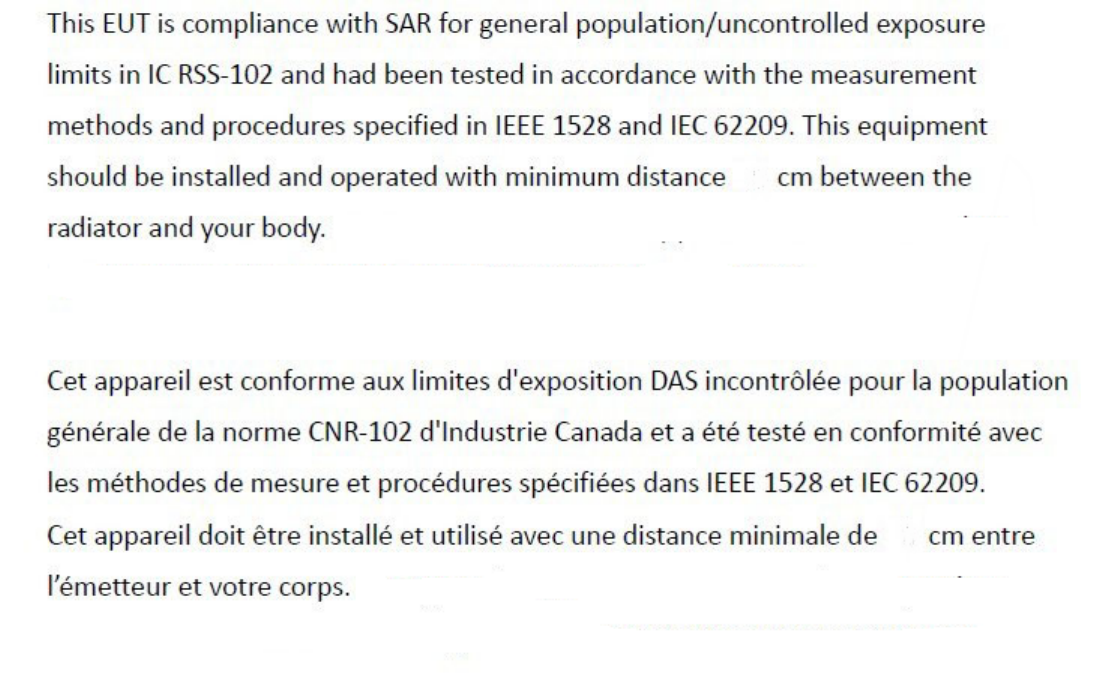
Https://sms-sgs.ic.gc.ca/eic/site/sms-sgs-prod.nsf/fra/h_00013.html recherche IC: 8992A-W60W65 pour obtenir de plus amples informations incluent les valeurs SAR.
This product is compliance to IC RF Exposure requirements and refers to IC website
RF Exposure Information:
gain further information include SAR Values.
https://sms-sgs.ic.gc.ca/eic/site/sms-sgs-prod.nsf/eng/h_00013.html search for IC: 8992A-W60W65 to
Ce produit est conforme aux exigences d'exposition à RF RF et se réfère au site Web IC
Informations sur l'exposition RF:
Obtenir d'autres informations incluent les valeurs SAR.
0
0